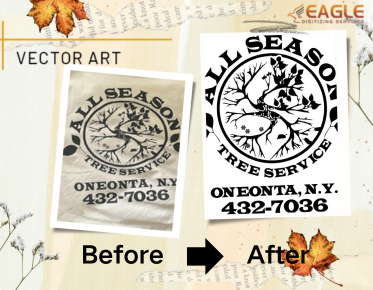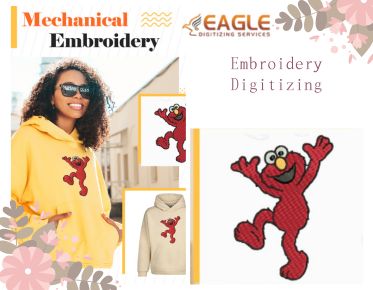Screen Printing Magic: Works on Materials Beyond Fabrics/Eagle Digitizing
Screen printing, a method celebrated for its versatility, has long been the go-to technique for producing vibrant, durable prints on fabric. Yet, the art of screen printing extends far beyond the realm of textiles. With its ability to adapt to various surfaces, screen printing opens a world of creative possibilities. From paper and plastic to metal and wood, the techniques and applications of screen printing are as diverse as they are exciting. For the top-notch online vector conversion, don't hesitate to get in touch with us.
Beyond Textiles: The Expanding World of Screen Printing Applications
Screen printing's evolution from fabric to other materials reflects its inherent flexibility. This technique, originally designed for apparel, now thrives across numerous substrates. This article delves into the expanding universe of screen printing, showcasing how this classic method performs on unconventional materials, and uncovering the boundless creative potential it offers.
Screen Printing on Paper Products
Paper Types: What Works Best for Screen Printing?
When it comes to screen printing on paper, not all types are created equal. Smooth, coated papers like cardstock and glossy prints are ideal as they absorb ink evenly and provide a clean finish. Papers with a rough texture or high absorbency may lead to uneven results. For crisp, professional prints, opt for papers specifically designed for screen printing or those with a smooth, non-absorbent surface.
Creating Custom Art Prints and Posters with Screen Printing
Screen printing is perfect for producing eye-catching art prints and posters. The technique allows for bold, vibrant colors and high opacity, which can make the artwork truly stand out. By layering colors and using various screen mesh sizes, artists can achieve a range of effects from fine details to dramatic, textured visuals.
Designing Unique Greeting Cards and Stationery
Custom greeting cards and stationery benefit from screen printing’s ability to create tactile, high-quality prints. The process adds a distinctive touch to designs, making each piece feel special and unique. From intricate patterns to bold graphics, screen printing can elevate the elegance of personal and business stationery.
Screen Printing on Plastics
Which Plastic Materials Are Ideal for Screen Printing?
Plastic materials such as acrylic, polycarbonate, and PET are well-suited for screen printing. These plastics have smooth surfaces that hold ink well and offer durability. The key is to ensure that the plastic is clean and free from oils or residues, which can interfere with ink adhesion.
Tips for Achieving Vibrant Prints on Plastic Surfaces
To achieve vibrant prints on plastic, use inks specifically formulated for plastic substrates. These inks adhere better and provide more vivid colors. Additionally, pre-treating the plastic surface with a primer can enhance ink bonding and result in a more durable print.
Applications of Screen Printing in Packaging and Promotional Items
Screen printing on plastic is popular in packaging and promotional items. It allows for high-quality branding on products like bottles, containers, and promotional giveaways. The durability of screen-printed plastics ensures that logos and designs remain intact through various handling and environmental conditions.
Exploring Wood as a Screen Printing Medium
How to Screen Print on Wood: Techniques and Tips
Screen printing on wood requires a few specific techniques to ensure success. Start by sanding the wood surface to achieve a smooth finish, which helps the ink adhere properly. Using a wood-specific ink and applying a clear coat after printing can also enhance the longevity and appearance of the print.
Creating Custom Signs and Art Pieces with Wood Printing
Wood offers a unique canvas for screen printing, providing a natural texture that can complement your designs. Custom signs, wall art, and decorative pieces benefit from the rich, organic quality of wood, and screen printing adds a professional, polished touch to these creations.
The Benefits of Using Screen Printing on Wood
Screen printing on wood brings a distinct aesthetic that combines rustic charm with vibrant visuals. The process allows for detailed, durable prints that can withstand the test of time, making it an excellent choice for both decorative and functional wood items.
Screen Printing on Glass
Challenges of Printing on Glass: What You Need to Know
Printing on glass presents unique challenges, including ensuring proper ink adhesion and achieving clarity on a smooth surface. Glass’s non-porous nature requires specific inks and techniques to ensure that prints adhere properly and resist smudging or peeling.
Techniques for Achieving Crisp Prints on Glass Surfaces
To achieve crisp prints on glass, use specialized glass inks and ensure the surface is thoroughly cleaned before printing. Applying a primer or using a heat-setting process can also improve ink adhesion and print quality. Testing on sample pieces can help fine-tune your approach.
Unique Applications: Decorative Glassware and Windows
Screen printing on glass opens up creative possibilities for decorative glassware, windows, and even shower doors. Custom designs can enhance both the functional and aesthetic appeal of glass objects, making them ideal for personalized gifts or stylish home decor.
Metal and Screen Printing: A Perfect Match?
The Best Metal Types for Screen Printing
Metals such as aluminum, stainless steel, and brass are ideal for screen printing due to their smooth, flat surfaces and durability. These metals can hold detailed prints and withstand various environmental conditions, making them suitable for a wide range of applications.
Tips for Preparing Metal Surfaces for Printing
Proper preparation of metal surfaces is crucial for achieving high-quality prints. Clean the metal thoroughly to remove any oils or dirt, and consider applying a primer to enhance ink adhesion. Ensuring a smooth, even surface will contribute to a more precise and durable print.
Real-World Examples of Screen Printed Metal Products
Screen printing on metal is used for a variety of products, including signage, nameplates, and industrial labels. Its durability makes it suitable for items exposed to harsh conditions, and the ability to produce detailed designs ensures that branding and informational graphics are clear and effective.
Screen Printing on Ceramics and Pottery
How to Successfully Print on Ceramic Surfaces
Printing on ceramics requires specialized ceramic inks that can withstand high temperatures during firing. Prepare the ceramic surface by cleaning it and applying a base coat if necessary. The print is then applied and set through a kiln firing process to ensure durability.
Techniques for Ensuring Durability of Printed Ceramics
Durability is key in ceramic screen printing. Use high-quality, heat-resistant inks and follow proper firing procedures to ensure that prints adhere well and remain intact through daily use. A clear glaze can also be applied over the print to provide additional protection.
Applications in Custom Dinnerware and Artistic Pieces
Screen printing on ceramics is perfect for creating custom dinnerware, decorative tiles, and artistic pottery. It allows for intricate designs and personalization, making each piece unique and tailored to individual preferences or branding needs.
Exploring Non-Traditional Surfaces: Leather and Faux Leather
Screen Printing on Leather: Techniques and Considerations
Screen printing on leather involves using flexible inks that adhere well to the material’s texture. Leather should be prepped with a primer or conditioning treatment to ensure proper ink adhesion. The printing process should be done carefully to maintain the leather's natural look and feel.
Customizing Bags, Jackets, and Accessories with Screen Prints
Leather and faux leather are excellent substrates for screen printing, allowing for the customization of items like bags, jackets, and accessories. Screen printing adds a personal or branded touch, creating unique, stylish products that stand out.
Caring for Screen Printed Leather Products
To maintain the quality of screen-printed leather items, avoid excessive exposure to moisture and sunlight. Regularly clean with appropriate leather care products and apply conditioning treatments as needed to keep the material supple and the print vibrant. For the excellent online vector artwork conversion, have no qualms about getting in touch with us.
Screen Printing on Walls and Murals
How to Use Screen Printing for Large-Scale Art Projects
Screen printing is ideal for large-scale art projects such as murals. The process allows for precise, repetitive patterns and vibrant colors that can transform blank walls into striking visual statements. Use large screens and carefully plan the layout to ensure consistent results.
Tips for Preparing Wall Surfaces for Screen Printing
Prepare wall surfaces by cleaning and priming to ensure that the ink adheres properly. Smooth out any imperfections and consider using a wall primer to create an even base. Proper surface preparation is crucial for achieving a high-quality, long-lasting print.
Transforming Spaces: The Impact of Screen Printed Murals
Screen-printed murals can dramatically enhance the ambiance of a space. They offer a unique way to add artistic flair and convey messages through large-scale visuals. Whether for commercial or residential settings, these murals make a bold statement and create memorable environments.
Innovative Uses in Automotive and Industrial Applications
Screen Printing for Custom Car Parts and Accessories
Screen printing is used in automotive industries to create custom designs on car parts and accessories. Durable inks and precise techniques allow for high-quality prints on surfaces like dashboards, trim pieces, and decals, enhancing vehicle personalization.
The Role of Screen Printing in Industrial Labeling
In industrial settings, screen printing is employed for labeling equipment, machinery, and tools. The technique provides durable, legible labels that withstand harsh environments and frequent handling, ensuring clear identification and compliance.
Benefits of Using Screen Printing in Manufacturing
Screen printing offers numerous benefits in manufacturing, including cost-effectiveness, durability, and high-quality output. It allows for the efficient production of detailed designs and labels on various materials, contributing to streamlined manufacturing processes.
Common Challenges and Solutions
Adhesion Issues: What to Do When Prints Don’t Stick
Adhesion problems can arise when printing on non-fabric materials. Solutions include ensuring proper surface preparation, using the right type of ink, and applying a primer if necessary. Conducting tests on sample materials can help identify and resolve adhesion issues.
Overcoming Color Challenges on Non-Fabric Materials
Color challenges may include poor color accuracy or fading. To overcome these issues, use inks specifically designed for the material and adjust color profiles as needed. Testing and calibrating your equipment can also improve color consistency.
Troubleshooting Common Problems in Screen Printing
Common problems in screen printing, such as smudging, inconsistent ink application, and misalignment, can be troublesome. To troubleshoot these issues, one should check the screen mesh tension, ink consistency, and curing times. Regular maintenance of equipment and thorough testing can help prevent and address these problems.
Eagle Digitizing offers vector graphics conversion services. The world of screen printing is vast and ever-expanding. From paper and plastic to metal and ceramics, the ability to print on diverse surfaces opens up endless creative possibilities. By venturing beyond traditional fabrics and exploring new materials, you can unlock a treasure trove of design opportunities and push the boundaries of what’s possible in printmaking.


